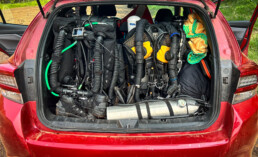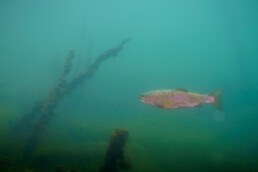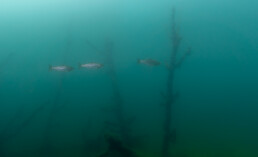
Bubble Free in Cuyuna Country
This past Monday, I took a small road trip with my friend Heather to Crosby, Minnesota, which—despite sounding like a town invented by Norman Rockwell and later abandoned by him—happens to be one of the best scuba diving spots in the state. It’s about 100 miles from Duluth, which feels like a manageable distance until you’re wedged between rebreathers, drysuits and bailout bottles in a tiny Subaru Impreza. My old Mercedes has air conditioning that functions primarily as a historical artifact, so we went with Heather’s car and made peace with the clown-car aesthetic.
We were heading for the Cuyuna Lakes State Recreation Area, a former iron-mining region that was flooded into usefulness after the mining boom fizzled out. It’s now home to 27 improbably gorgeous lakes and nearly 50 dive sites, all sprinkled across a piney, slightly surreal landscape of excavated rock and rugged beauty. One of the flooded pits—formerly known as Feigh Mine and it’s access point now branded the “Rally Point”—was recommended to us by the folks at the Minnesota School of Diving in Brainerd. Good visibility, lots of fish, they said.
In the last decade or so, Cuyuna has become something of a darling among mountain bikers. It’s one of only 39 official Ride Centers in the world, according to the International Mountain Biking Association—a fact I didn’t even know was a thing until I parked next to several carbon-fiber bikes whose total weight was less than my left fin. The once-sleepy mining town now boasts a yoga studio, a craft brewery, and more Lycra than a 1980s aerobics video.
In a parking lot shimmering with carbon fiber and brightly clad cyclists, we emerged like time travelers from a less graceful era—draped in layers of wool, fleece, and complicated gear that hissed and clanked and looked mildly combustible. The bikers clipped into their pedals and zipped off with aerodynamic ease; we waddled to a picnic table with the weight and dignity of a walrus. As we suited up beside the water, the sun climbed higher, and we began to stew gently in our suits—a slow, wool-lined simmer of anticipation and absurdity.
The visibility in Feigh Mine was a sparkling 20 to 30 feet. Sunlight filtered through the water like stage lighting for trout. At a balmy 51°F, it was practically spa-like by Minnesota standards. Heather and I were both diving rebreathers, largely bubble and noise free – and I suspect that may be why the rainbow trout swirled around us in curious loops. They’re jittery little creatures, constantly darting and changing direction like toddlers on espresso.
Bass, sunfish, even a pike made an appearance, though none of them had quite the charisma of a loon I once filmed here a few years back. That encounter remains one of my all-time favorite diving moments. The loon swam right up to me, stared me down, and circled back again. Only later did I realize it was probably mesmerized by the little fishing lure I keep dangling above my camera. The lure is still there, still waiting. No loons today, but hope, like rust, never sleeps.
The dive itself lasted an indulgent two hours and twenty minutes. Shallow, warm, colorful—the way I like it. Heather might have preferred something deeper and more technical, but for me, this was perfect: easy light, playful fish, no surge, no urgency. I took a few photos that were… fine. But the experience wasn’t about the photos. It rarely is.
We emerged wrinkled and waterlogged, packed up our gear, and detoured to Dairy Queen like pilgrims at the end of a holy rite. A chocolate malt can do marvelous things for the soul, especially when your body has been floating in a flooded mine for the better part of the afternoon.
I imagine we’ll find ourselves back here before the summer’s done. These lakes have a way of calling you home. The loon, I think, was a gift—a quiet, once-in-a-lifetime grace note. But I’ve learned never to speak too confidently about what won’t happen again. I said the same about diving Lake Superior in the winter, and now I carry a lure like a charm, hoping lightning—or loons—might strike twice.




